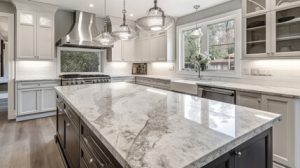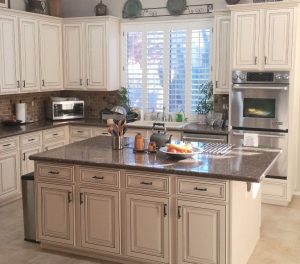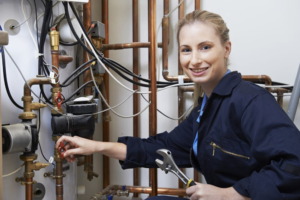A well-designed kitchen is more than a workspace for preparing meals. It’s a natural gathering spot that fosters lasting memories with loved ones.

Kitchen Remodeling Lexington KY fundamentally alters the design and layout of a space. It typically involves complex design alterations and construction work including electrical and plumbing upgrades and possibly property extensions.
A kitchen is the heart of a home. It’s a space where families gather to prepare meals and share a meal with friends. Aesthetics plays a crucial role in this space as it affects how the kitchen functions. Balancing the aesthetics and functionality of the kitchen is a delicate balance that requires careful consideration of many different elements to achieve a functional and visually appealing space.
The right kitchen design can set the mood, make cooking easier and more enjoyable, and add value to your home. A well-designed kitchen combines elements that appeal to the senses, from the color and style of the materials to the layout and lighting. The best kitchens combine modern innovations with timeless design features to create a space that will be as beautiful in years to come as it is efficient now.
Keren Richter, designer at White Arrow Interiors, specializes in creating kitchens that combine beauty and function. She says the key to striking the perfect balance is to have a clear vision and focus on the essentials of the kitchen before starting your project.
She suggests avoiding trends that may quickly fade, and instead opting for timeless designs and high-quality materials. For example, using durable surfaces such as granite or quartz and wood veneers ensures that your kitchen will look attractive and functional for years to come.
Another important factor is to consider how the kitchen will flow and connect with other spaces. For example, designing a large island with seating for eating and socializing makes the kitchen feel more spacious and welcoming. Also, removing walls that separate the kitchen and dining areas promotes a more open concept.
Aesthetics in the kitchen can be influenced by the size of the room, the budget, and personal preferences. Minimalist kitchens often feature a neutral color palette, while rustic and country styles incorporate warm, rich colors to add character. Other design elements, such as coffered ceilings, wainscoting, molding, and other architectural details can add interest to the kitchen.
The best kitchens reflect the homeowner’s personality and lifestyle. For example, a traditional kitchen might use classic elements such as stained woods and intricate details to achieve an elegant and welcoming space. As sustainability becomes an increasing concern, more New Zealand homeowners are choosing eco-friendly options for their kitchens. This includes incorporating environmentally-friendly materials and sustainable appliances to reduce their impact on the environment and increase the value of their homes.
Functionality
A well-planned kitchen renovation or remodel combines style and functionality to create a space that suits the homeowner’s personality and meets their lifestyle needs. This includes optimizing the layout of the kitchen space and incorporating modern amenities to ensure an efficient workflow.
For example, a wall may be removed to open the kitchen to the living area for social interaction or to allow for a more spacious work environment. Modern kitchens also incorporate smart appliances that make the cooking process easier and more sustainable, such as programmable ovens or energy-saving refrigerators.
Lastly, proper lighting can enhance the functionality of your kitchen by illuminating the workspace adequately for food prep and providing a warm, inviting atmosphere for dining. A professional will help you select the perfect fixtures to achieve these goals.
Safety
The kitchen is the heart of your home, and a well-planned kitchen remodel can transform it into an efficient space where culinary creations are made and families gather. It can also add significant value to your home, which is why it’s important to plan ahead and set a realistic budget.
It’s a good idea to visit a number of showrooms and online galleries in order to get a feel for different kitchen layouts and designs, and to figure out what features you would like to include in your own. Be sure to take notes as you tour each exhibit, and save any pictures or videos that catch your eye. This will help you decide on a final design that suits your needs and taste.
Another crucial safety measure that must be taken into account during a kitchen makeover is to ensure that the work area is kept as clear as possible at all times. This will help avoid any unnecessary injuries during the renovation process. Additionally, it is vital to always make sure that all tools are stored away after each day’s work and that children are not able to access the work area.
Before you start your kitchen remodeling project, it’s a good idea to familiarize yourself with the tools you’ll be using. This will prevent any accidents from happening due to unfamiliarity with the tools. Furthermore, it’s a good idea to wear protective gear such as gloves and a hard hat. This will protect you against any potential head and hand injuries.
While a kitchen remodel can be an exciting and rewarding experience, it’s important to be prepared for the disruption to your daily routine. The constant noise, dust, and comings and goings of contractors can be stressful. It’s also a good idea to establish a clear line of communication with your Kowalske designer and project manager, so that you can voice any concerns promptly.
Lastly, it’s a good idea to make plans for alternative food sources during the remodel. Purchasing non-perishable foods and eating out more often can help you maintain your health and sanity during the renovation.
Value
Investing in a kitchen remodel is one of the best ways to increase the value of your home. With the right upgrades and careful planning, you can turn your kitchen into a beautiful living space that is both functional and stylish. However, it is important to remember that not all kitchen improvement projects will yield the same return on investment. It is crucial to choose the right upgrades and to hire qualified professionals to ensure a successful outcome.
There are many factors that can influence the ROI of a kitchen remodel, including project scope, material choices, and geographical location. In addition, labor costs can also have a significant impact on the final cost of your renovation. Therefore, it is crucial to have a clear vision of what you want to achieve before beginning the process. This can help you stay on budget and avoid overspending.
Kitchen remodeling projects vary in scope and price, and the average ROI varies depending on the type of renovation and local real estate market conditions. However, most kitchen remodels return at least some of the initial investment.
Upscale major kitchen remodels with high-end materials and premium appliances tend to have the highest ROI, followed by midrange major kitchen remodels and minor kitchen renovations. The ROI of a kitchen remodel can also be affected by the quality of materials used and how well the remodel is executed.
To maximize the return on your kitchen remodel, it is essential to choose upgrades that will appeal to a wide range of buyers. While it is tempting to personalize your kitchen with unique tile patterns and specialized appliances, you should aim for a balance between functionality and aesthetics. Over-personalization can deter potential buyers and could result in your kitchen sitting on the market longer than necessary.
To increase the value of your kitchen, you should also consider upgrading to energy-efficient appliances and fixtures. While these upgrades may have a higher price tag, they can help you save money on utility bills and reduce your environmental footprint. Moreover, newer appliances and fixtures tend to be more durable than older models, so they can last for a long time and retain their value over time.


